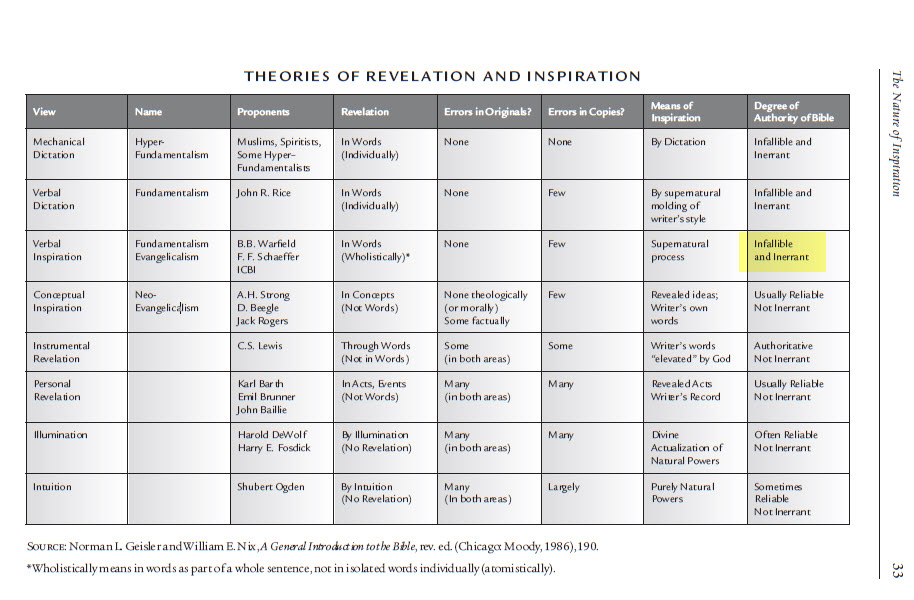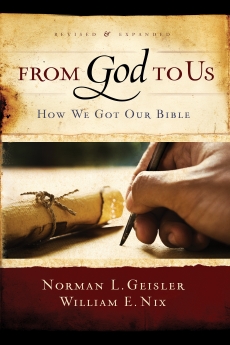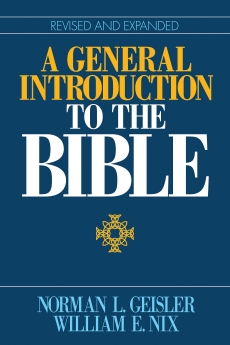From God to Us: How we got our Bible (2012) & A General Introduction to the Bible (1986)
Versions
The original edition of From God to Us (or FGTU) was published in 1974 and has since sold over 78,000 copies. It was an abridgement of the classic, >700 page book A General Introduction to the Bible (or AGITTB) by Geisler and Nix. The 2012 revision of From God to Us was a major revision which helped bring the book up to date and also expanded it from from 255 pages to 412 pages. The 2012 edition is available as a paperback and an eBook at:
ChristianBook and Amazon and Moody Publishers.
Description of the 2012 FGTU
From God to Us is the only book of its kind in print, covering the inspiration, canonization, transmission, and translations of the Bible. The Bible was written in multiple languages by dozens of authors whose lives spanned a period of more than fifteen hundred years. How did it all come together? Best-selling authors Norman Geisler and William Nix thoroughly answer this question and many more in this revised and expanded edition of a classic which has sold more than 78,000 copies. Helpful charts, photos, and indices have been added, rendering this book ideally suited for Bible students, pastors, and professors. Major topics addressed include: theories of inspiration, the process of canonization, major manuscripts and recent discoveries, textual criticism, Greek and Latin translations, and modern English translations. The entire field of general biblical introduction is covered.
Where did the Bible come from? How do we know the right books are in the Bible? Does the Bible contain errors? What are the oldest copies we have of the Bible? How do we know that the Bible hasn’t been changed over the years? Why are there so many translations of the Bible, and which one should I use? These are just some of the important questions about the Bible that are discussed in this book. Understanding basic facts about the origin of the Bible is essential for every Christian, but it can also be confusing and difficult. Here, two well-known scholars, authors of a more technical book, A General Introduction to the Bible, explain simply and clearly these basic facts. Inspiration, the biblical canon, major manuscripts, textual criticism, early translations, and modern versions are some of the major topics discussed. Careful explanations of important points are given throughout, as the entire field of biblical introduction is covered. Completely updated and revised edition of the 1974 work (more than 78,000 copies sold). Helpful charts have been added, along with an index of subjects, persons, and Scripture. This book is ideally suited for Bible students, pastors, and professors. While writing for readers without previous training, the authors do not gloss over difficult and complex issues when they arise. The nature of inspiration, the extent of the canon, and the usefulness of modern versions are all clearly discussed. The authors write: “The chain of communication from God to us is strong. It has several solid links: inspiration, collection, transmission, and translations. The strength of these links provide the contemporary Christian with the moral certitude that the Spirit-inspired original text of Scripture has been providentially preserved by God so that for all practical purposes the Bible in our hands is the infallible and inerrant word of God.”
Accompanying Lectures
Norm’s lecture series on the topic of “From God to Us” is available in video (MP4) format (with PowerPoint slide decks) either under the title of “From God to Us” or “FastTrack Seminary” at the NGIM store (visit http://NGIM.org). The lectures may also be available as audio (MP3) lectures as well. As of 2020, it is available here.
Retirement and Revisions
The authors and publisher agreed that this 2012 revision of FGTU is the successor to A General Introduction to the Bible (or AGITTB for short). We don’t expect any further updated revisions of AGITTB. You can probably still order a hardback copy of the 1986 version of AGITTB from Amazon. The older and outdated version of FGTU may still be available in paperback and Kindle editions here.
Errata
Page 33. In the table titled “Theories of Revelation and Inspiration” on page 33, there is one mistake in a cell of a table, on the row of “verbal inspiration” view (held by Warfield, Schaeffer, ICBI, and Geisler and Nix too) where “infallible but not inerrant” should instead read “infallible and inerrant.” This table was taken from the 1986 version of A General Introduction to the Bible, p. 190, which did not contain the mistake and helps to confirm that a mistake was made in editing. This mistake was found in the 2012 and 2013 prints of the book. Hopefully the publisher fixed this error after we reported it to them. The corrected version may be seen in yellow highlight in the image below:

Recommended Improvements by Steve Morrison
Between 2015 and 2019, Norm was very interested in using some of the meticulous research done by Steven M. Morrison, to improve AGITTTB and FGTU. However, Norm passed away before Steve’s research could be integrated. Hopefully in some future edition of FGTU we can at least include a new appendix that contains Steve’s recommendations. Until then, we will offer these recommendations in a PDF document here. While we cannot say that Norm approved of every one of these recommendations, we can say without hesitation that Norm was very favorable towards all of Steve’s research and recommendations and thus he probably would have approved of the ones offered here. Bill Nix also tended to be favorable to most of Steve’s recommendations. But since it seems that AGITTB and FGTU have been made immutable for the foreseeable future, we may not be able to include these updates in the books. If Bastion Books gets the rights from Moody Publishers, we may be able to include some of these recommendations in footnotes and appendices while taking pains to not alter any of the text by Norm Geisler and Bill Nix.
Recommended Improvements by Christopher Haun
Before Norm passed away in 2019, Norm Geisler told his son David Geisler that he hoped that AGITTB could be revived, revised, and republished and that he would like Christopher Haun to be the general editor. Christopher took his first seminary course on Bibliology with Norm as his professor and AGITTB in 1996. Christopher also assisted Norm with many projects related to biblical inerrancy (between bastionbooks.com, normangeisler.com, and defendinginerrancy.org) between 2010 and 2019. Norm mainly wanted the research of Steve Morrison to be incorporated into the revived tome. But Bill Nix and Barbara Geisler agreed that AGITTB should be made into an immutable reference work for posterity and should not be updated by anyone other than Bill or Norm. Barbara agreed that perhaps in the future a book like AGITTB or FGTU may have updates in appendices referenced by footnotes.
Christopher plans to offer some recommendations for how AGITTB could possibly be improved and updated here in the future. Chapter 30, for example, discusses various translations of the Bible but ends with the 1970 version of the NEB. One might wish for insights on newer translations such as NIV, NKJV, NASB, ESV, CEB, NET, etc. The corresponding chapter was updated in the 2012 version of FGTU. The various chapters that discuss canonicity, as an other example, remain excellent for today but are arguably a little stale. The current debates over canon have brought up additional points that arguably need to be addressed. (See Michael Kruger’s The Question of Canon for a good example of an update on this topic.) As a third example of staleness in the book, the section on “The Neo-Evangelical View of Inspiration” (178-180) settles for G.C. Berkouwer and Jack B. Rogers as the best representatives of Neo-Evangelicalism. While they are excellent choices for this, much has happened since 1986 in this area. (See for example Norm Geisler’s book Preserving Orthodoxy and Defending Inerrancy by Geisler and Roach.)

